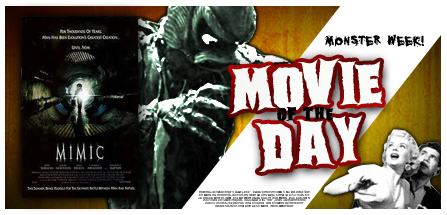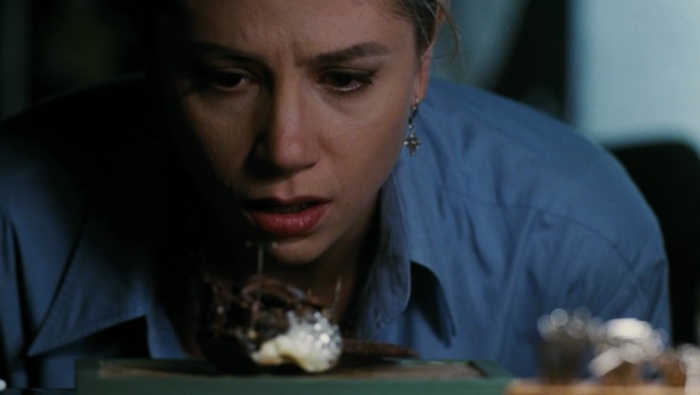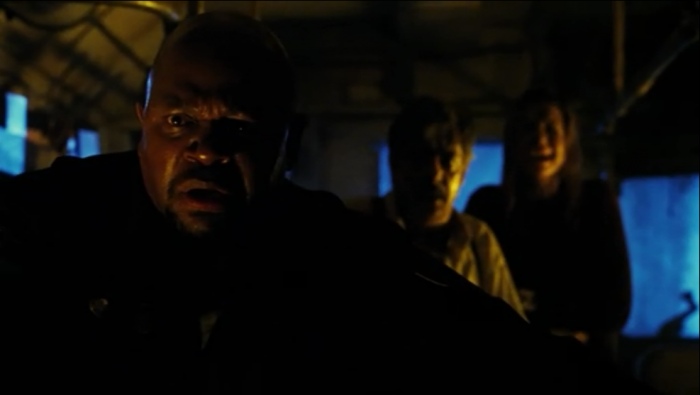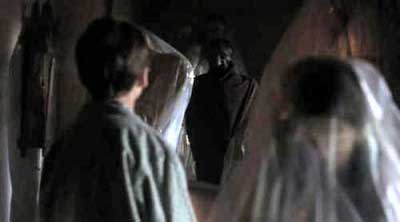
The Film: Mimic (theatrical: 1997. director’s cut: 2011)
The Principles: Mira Sorvino, Jeremy Northam, Josh Brolin, Charles S. Dutton, Giancarlo Giannini, and F. Murray Abraham. Directed by Guillermo del Toro.
The Premise: In New York City, scientists discover that cockroaches are spreading a deadly disease that is killing the city’s children. So entomologist Susan Tyler (Mira Sorvino) genetically engineers a super-bug she names the “Judas Breed,” which is designed to take out the cockroaches then eventually die out itself. The first part of her plan works — the city’s plague ends. But the Judases don’t die out. They breed and evolve at an astonishing rate. Several years later people start going missing in New York’s subway tunnels. Turns out the Judases have evolved to human size and are able to crudely mimic our appearance. And they’re hungry. And they’re friendly to special-needs kids.

Is It Good: The passage of time has an odd effect on horror movies. Great films will always get their due. But when it comes to mid-range films horror fans tend to be very judgmental when they’re brand new, and wildly forgiving when they’re old. Sure, I’d rather watch The Toolbox Murders (1978) than The Collector (2009), but I wouldn’t even dream of pretending Toolbox is actually a good movie, or better than something like The Collector. Getting “older” seems to lend horror films a sense of charm. We become willing to cut films slack. And the much-maligned 1990s are just now getting old enough where we can start cutting a lot of the decade’s mid-range horror films some slack. Mimic is just such a film — positioned perfectly for absolution.
For one thing, it isn’t a bad movie. It most certainly isn’t a great movie. But it performs. Secondly, it was Guillermo del Toro’s first American film — now it has some retroactive weight to it, like any other lesser work in the canon of a great director. Thirdly, lacking the international clout that Pan’s Labyrinth brought him, back in the ’90s del Toro lost most of his creative battles on Mimic to Miramax. Sadly, most of the key battles were lost before the cameras ever rolled, but del Toro now has the biggitty-balls to overturn all the battles he lost in post-production. Similarly to the Assembly Cut of Alien 3 (which attempted to restore David Fincher’s original vision as close as realistically feasible), Mimic: The Director’s Cut is not a radical adjustment. It isn’t Blade Runner. But it is an improvement in some unexpected ways. While some extra plot and character scenes were added to the director’s cut, story-wise the most potent alteration is what del Toro took out, not what he put back in. He removed a lot of second unit footage, editing choices, and sound FX that had attempted to make the movie more in-your-face with lame jump scares that del Toro never intended. Now the movie flows at an interesting and relaxed pace. And Del Toro was also able to finally realize the visual tone he’d always wanted. The whole color palette is different. The film looks gorgeous now, instead of generically “accessible,” as it did in the ’90s.
With the track record del Toro has had, it is a shame we never got the Mimic he initially set out to do. But the film has its moments and charms. On the nostalgia front, the film now offers up some casting remember-whens. An excellently surly Josh Brolin during the long, nebulous phase of his career between Goonies and his rise to stardom in recent years. Charles S. Dutton back when he was the go-to character actor for genre films in need of a tough guy with a heart (to die protecting a white woman). Mira Sorvino in her brief post-Oscar phase as a leading lady. Jeremy Northam when people kept foolishly thinking he didn’t come off as slimy on the screen. And F is for fucking Murray Abraham! Though Mimic still ranks as the least del Toro-y of del Toro’s films, his fingerprints are more so visible in the director’s cut than they were previously. But my favorite del Toro bit was always there to begin with. Del Toro doesn’t believe in pulling punches in his films, particularly when it comes to children. Even back in 1997, when I walked out of Mimic complaining about how underwhelming it was, I was shocked and impressed that the film killed two kids who happen upon the giant insects. Having grown up on Spielberg and his disciples in the 1980s, I was well used to seeing rascally kids happening upon extraordinary or supernatural elements. I wasn’t used to seeing them become a hot lunch.
But the film’s greatest success is still the giant bugs themselves. The creature design is eery and fantastic, and typical del Toro in its almost unnecessary (but all the better because of it) eye for detail. As far as the story is concerned, the fact that the Judas bugs can moderately imitate humans isn’t even that relevant. This isn’t a Body Snatchers-esque tale. It is far more so just a creepy idea — an area that del Toro knows how to milk. The scenes with the autistic little boy who tries to mimic the Judas Breeds’ crude vocabulary of clicking sounds (by clacking together two spoons) are quite creepy and bizarre and a hint at the del Toro we all know now. Alas, even in the director’s cut, del Toro isn’t able to elevate the storyline to anything more than light horror entertainment (the attempts at philosophical commentary on science versus nature fall mostly flat), but he was at least able to recapture the atmosphere he wanted. The look of Mimic: The Director’s Cut is a pleasure.

Is It Worth A Look: The blu-ray for the director’s cut is a very worthy use of your time even if only as an excuse to listen to del Toro talk about his craft — the blu is loaded with supplemental material featuring the passionate and verbose Mexican.
Random Anecdote: Mimic marks the first time that del Toro worked with Doug Jones, who played one of the insects in the film.
